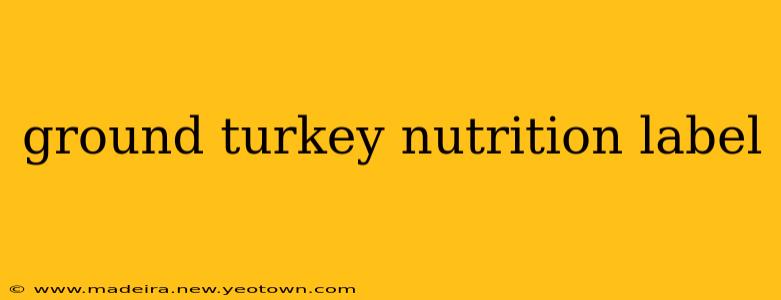Let's be honest, ground turkey has become a kitchen staple. Leaner than ground beef, it's a popular choice for those watching their waistlines and seeking healthier options. But navigating that nutrition label can feel like deciphering a secret code. This post will unravel the mysteries of the ground turkey nutrition label, helping you make informed choices for your family's meals. We'll explore everything from fat content to protein power, addressing common questions along the way.
What's the Typical Nutritional Breakdown of Ground Turkey?
Imagine this: You're standing in the supermarket, staring at a package of ground turkey. The label boasts numbers, percentages, and maybe even some baffling terms like "DV" (Daily Value). It can be overwhelming. A typical 3-ounce serving of 93% lean ground turkey generally contains:
- Calories: Around 150-180
- Protein: A powerhouse, delivering roughly 20-25 grams. This is crucial for building and repairing tissues, making it a great choice for active individuals and those focused on muscle growth.
- Fat: This is where the percentage matters. 93% lean means 7% fat, which translates to roughly 5-7 grams of fat per serving. This is significantly lower than many ground beef options. However, be aware that the leanness percentage can vary.
- Saturated Fat: This type of fat should be limited in your diet, and ground turkey typically contains a modest amount (around 2-3 grams per serving in 93% lean).
- Cholesterol: Ground turkey contains cholesterol, but the amount is relatively low compared to some other meats.
- Sodium: This can vary depending on the brand and whether any added seasonings are present. Look for lower-sodium options.
How Does the Nutrition Vary Based on Leanness Percentage?
This is a crucial point. The percentage on the label (e.g., 93%, 90%, 85%) refers to the percentage of lean meat, not the percentage of fat. The lower the percentage, the higher the fat content. A 90% lean ground turkey will have more fat and calories than 93% lean ground turkey. If you're strictly monitoring your fat intake, opt for the higher lean percentage.
What About Added Sodium in Ground Turkey?
Many ground turkey products have added sodium, either for preservation or taste enhancement. This is something to keep an eye on, especially if you're watching your sodium intake for health reasons. Check the nutrition label carefully and compare different brands to find the lowest sodium options. You could also consider purchasing ground turkey without any added seasonings and seasoning it yourself.
Is Ground Turkey a Good Source of Protein?
Absolutely! Ground turkey is an excellent source of protein, making it a fantastic addition to any diet focused on muscle building or maintenance. The high protein content also contributes to feelings of fullness, helping with weight management.
How Many Calories are in a Serving of Ground Turkey?
As mentioned before, the calorie count varies depending on the leanness percentage. A 3-ounce serving of 93% lean ground turkey typically contains around 150-180 calories. Remember to always check the specific label for the most accurate information.
Are There Different Types of Ground Turkey?
You'll often find variations, such as ground turkey breast (leanest option), ground turkey thighs (higher fat, richer flavor), and even blends of breast and thigh meat. The nutritional information will differ based on the type of ground turkey. Consider your dietary goals when making your selection.
Conclusion: Informed Choices for Healthier Eating
The ground turkey nutrition label, while initially daunting, becomes much more accessible once you understand how to read it. By focusing on the leanness percentage, paying attention to added sodium, and considering your individual dietary needs, you can confidently choose the ground turkey that best fits your lifestyle. Remember, mindful choices at the grocery store pave the way for healthier and more delicious meals!

